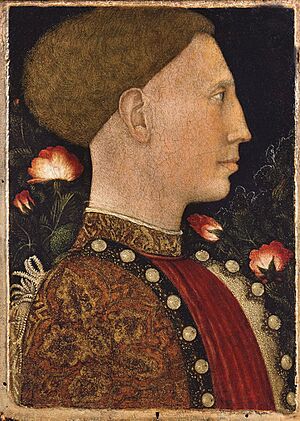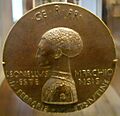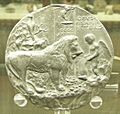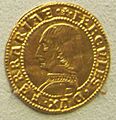Leonello d'Este facts for kids
Quick facts for kids
Leonello d'Este
|
|
|---|---|
| Marquis of Ferrara and Duke of Modena and Reggio Emilia | |

|
|
| Coat of arms |  |
| Born | 21 September 1407 Ferrara |
| Died | 1 October 1450 (aged 43) |
| Family | Este |
| Spouse | Margherita Gonzaga: m. 1435–1439 Mary of Aragon: m. 1444–1450 |
| Father | Niccolò III d'Este |
| Mother | Stella de’ Tolomei |
Leonello d'Este (born September 21, 1407 – died October 1, 1450) was an important ruler in Italy. He was the Marquis of Ferrara, Modena, and Reggio Emilia from 1441 to 1450. Even though his father, Niccolò III d'Este, had other sons, Leonello was chosen to be his successor. This was because Leonello was known for being a good person, having a great education, and being well-liked by everyone. The Pope even recognized him as the rightful heir.
Unlike some other leaders in his family, Leonello wasn't mostly focused on gaining power. Instead, he is best known for supporting the arts, literature, and culture. During his rule from 1441 to 1450, his smart court and growing knowledge helped transform the city of Ferrara. With help from his teacher, Guarino Veronese, Leonello started important changes, especially at the University of Ferrara. His work helped set the stage for many achievements by the House of Este in the future.
Contents
Leonello's Life Story
Leonello was one of three sons born outside of marriage to Niccolò d'Este III and Stella de' Tolomei. He learned military skills from a famous soldier named Braccio da Montone. He also had a great teacher, Guarino Veronese, who taught him how to be a good ruler. Guarino later became a professor at the University of Ferrara.
In 1425, after his older brother Ugo was executed, Leonello became the only heir to his father. In 1435, he married Margherita Gonzaga. The Pope also recognized him as a legitimate son. Margherita had a son named Niccolò in 1438 but sadly died in 1439. In late 1441, Leonello became the ruler of his father's lands after Niccolò died.
Leonello had a strong educational background. Because of this, he brought big changes to Ferrara in its economy, politics, and culture. In May 1444, Leonello married Mary of Aragon, who was 19 years old. She was the daughter of King Alfonso V of Naples. This marriage was important for political reasons. Leonello stayed neutral in fights between Milan and Venice to keep Ferrara stable. He wanted to expand Ferrara's power by making alliances with nearby regions through marriage. King Alfonso V's victory in Naples helped make this diplomatic marriage possible.
Leonello was a skilled politician. He was responsible for building Ferrara's first hospital. But he was most famous as a man of culture. Famous artists like Pisanello, Iacopo Bellini, Giovanni da Oriolo, Andrea Mantegna, Piero della Francesca, and Rogier van der Weyden worked at his court. Leonello died in 1450 when he was 43. His brother, Borso d'Este, became the next ruler.
Family Background and Succession
Parents and Becoming Ruler
Leonello d’Este’s father, Niccoló d’Este III, was also born outside of marriage. Niccoló became the rightful heir to Leonello's grandfather, Alberto, when he was nine. However, Leonello's situation was different because he had younger brothers who were born within marriage.
Niccoló needed to show that Leonello was the best choice to be his successor. He gave three main reasons: Leonello's personal qualities, his popularity, and official recognition from the Pope. Leonello was praised for his strong leadership and good character. He was also taught by respected humanist teachers like Guarino da Verona. His father believed this high level of education made Leonello stand out. People also liked Leonello very much, and his father saw that they supported him as the next ruler. The Pope officially agreed that Leonello was the legitimate heir. By 1434, Leonello was given a lot of power to rule alongside his father.
Leonello's marriage was also important for relations with nearby cities. The House of Este owed money to Gianfrancesco Gonzaga, the ruler of Mantua. Instead of paying with money, Gonzaga agreed to let his daughter Margarita marry Leonello. In return, Niccoló promised that Margarita's children would become lords in Ferrara. This marriage helped both rulers by settling the debt and improving their relationship. It also gave Leonello political support from another ruler.
Leonello's younger brothers also wanted to be the ruler. Because of possible conflicts, Leonello's father was careful about officially naming Leonello as his successor. Even though Leonello ruled with his father since 1434, Niccoló waited until his last will, just before he died, to formally name Leonello as his heir. Niccoló's will also protected his legitimate sons, Ercole and Sigismondo, by giving each of them 10,000 ducats. After his father died in 1441, Leonello finally became the official Marquis of Ferrara.
Family History and Heirs
The way Leonello became ruler, even though he was born outside of marriage, fits into the history of the House of Este. This family often chose sons born outside of marriage as their future rulers. This also shows how people thought about gender and political power in the House of Este at that time. Sons born outside of marriage were often preferred over legitimate daughters for succession. Leonello himself was also followed by a ruler who was born outside of marriage. His brother, Borso, who had the same mother as Leonello, was later chosen to be Leonello's successor.
Culture, Art, and Literature
Culture in Ferrara
The University of Ferrara
The University of Ferrara started in 1391. However, it wasn't until 1442, one year after Leonello d’Este became ruler, that it truly became a working university. It then had enough professors to teach major subjects like canon law (church law), logic, philosophy, and medicine. So, while 1391 is the traditional start date, 1442 is seen as its real founding year. This is when it grew much larger and became well-known in Ferrara and nearby towns.
The university was first allowed to grant degrees in 1391. But it only had two law professors, and there's no proof of other subjects being taught at a university level. The university even closed in 1394. Later, in 1418, Leonello's father, Niccolò III, tried to reopen it but failed.
In 1442, Leonello d’Este and the city of Ferrara agreed to reopen the university. Great humanists and Leonello's teacher, Guarino Guarini of Verona, likely encouraged Leonello to create a fully working university.
A meeting in January 1442 led to an agreement that a university was needed. They said it would be "a distinguished center of learning" that would bring fame to the city. It would also make it easier for local men to get degrees. Plus, more students would help the city's economy. To raise money, the city added a sales tax on meat. This money paid a large part of the professors' salaries. Leonello also helped financially to keep the university going.
The official opening date for the university was October 18, 1442. Guarino Guarini of Verona became a humanist professor there. He gave a speech praising humanist and university subjects. By the end of Leonello's rule in 1450, records show there were twelve law professors and thirteen arts professors. The university had become very successful, just as Leonello and the city had hoped.
Learned Courts and Humanism
Leonello was highly respected by humanists. They saw him as a great supporter of the arts and a perfect example of a prince and a man of learning. Leonello's education in the new ideas of studia humanitatais (humanities) and his love for the arts helped him create a widespread cultural movement in Ferrara.
He ordered the reform and expansion of the University of Ferrara. He also held public and private meetings that brought scholars to teach at the university. These included Teodoro Gazs, a master of Greek, and Basinio Basini, a poet famous for his Latin speeches. Leonello was praised for his successful peacemaking. He was called salus Italiae (savior of Italy) and specs Italum (mirror of Italy). In 1448, a poem called "Melegridos" was used to show how Leonello handled politics. Leonello d'Este became known as a patron of the arts to humanists like Angelo Decembrio.
Angelo Decembrio was a humanist scholar from Milan who moved to Ferrara in 1438. He wrote a book called De Politia Litteraria Variisque Poetae Virgilli Laudbibus before 1447. This book was a dialogue about how to keep literature refined in a court. It also described Ferrara and included Angelo's thoughts about Leonello. The book described Ferrara's streets, gardens, and villas. It also highlighted the d’Este court, especially its huge library. This library, with its rich furnishings and carefully chosen books, showed how much the prince invested in culture. Leonello passionately added to the d’Este library, making it a true cultural center and boosting his prestige as an art patron.
Leonello d’Este's court had an amazing cultural energy that his successor, Borso d’Este, could not match. This might be why many scholars left Ferrara after Leonello died. Humanists like Decembrio, Gaza, and Basinio were among the most important thinkers to leave the Este court in 1450.
Music and Pietrobono
Pietrobono was a very successful and favored musician in Leonello's court. He played music on a lute. Pietrobono first appeared in Leonello's court in 1441. He was more famous than many other musicians in Ferrara. In Leonello's first year as ruler, Pietrobono, who was in his mid-twenties, was given twenty gold coins by Leonello. This was a common payment used by the Este family for musicians. By the mid-1440s, Pietrobono's pay increased a lot during Leonello's rule.
Artistic Achievements
Piero della Francesca
Leonello asked Piero della Francesca to paint large wall paintings (frescos) of famous Roman battles. He was especially interested in battles between the Roman general Scipio and the Carthaginian general Hannibal. Leonello's interest in ancient Rome came from his education and his exposure to humanism through his teacher, Angelo Decembrio. Leonello sometimes brought artists from the Low Countries (modern-day Belgium and Netherlands). This has led to discussions about whether Piero might have learned from Flemish artists. Piero would have met some of them, like Rogier van der Weyden, who was in Ferrara in the 1440s during Leonello's time.
The da Lendinara Brothers
Leonello hired Cristoforo and Lorenzo Conozi da Lendinara. They were experts in the art of inlaid wood, called intarsia. The brothers used to work for Piero Della Francesca. When Leonello hired them, they worked in his palace. Their friendship with Piero grew stronger because Piero was painting frescos near Leonello's estate.
Antonio di Puccio Pisanello
Leonello asked Pisanello to make special medallions. He wanted to be remembered long after his death and to show his fame and power to people in Ferrara, both then and in the future. The medals from 1441, 1444, and 1450 all show Leonello's qualities or his court. Each coin has a portrait of Leonello on one side, styled like a Roman emperor. The other side has an image that represents Leonello and his court.
The 1441 coin, called the Little Lion of Ferrara, was designed by Pisanello to look like an ancient Greek or Roman coin. Leonello collected such coins. The image of a feline (cat-like animal) is a play on Leonello's name, which means "little lion." His hair was also designed to look like a lion's mane, showing his status as marquis. This coin is in the British Museum.
The Singing Lion coin from 1444 also uses Leonello's name. The design with the lion and angels represented parts of the Este family history, especially linked to Leonello and his court. It is in the Victoria and Albert Museum in London, England.
The 1450 coin has the same bust style on the front as the earlier coins. This was to copy Roman money while showing the thirteenth Marquis of Ferrara. This coin is also in the Victoria and Albert Museum.
Some experts believe that even though Leonello and Pisanello designed the coins to look like ancient Roman money, their materials and making were still medieval. They also note that the process for making copies of these coins developed about a century after Leonello's death. So, Pisanello's coins for Leonello were an early step in developing coin copying in Ferrara.
Giovanni da Oriolo
Giovanni da Oriolo was an active artist in Faenza by 1439. Leonello d’Este hired him in 1447. Giovanni's only known work is his portrait of Leonello. Oriolo's portrait of Leonello was painted to look like a Roman coin. This style was common in 15th-century Italy. This painting is in the National Gallery in London, England.
Literature and Leon Battista Alberti
Leon Battista Alberti was a famous mathematician and architect. He worked with Leonello d’Este on a book called De Re Aedificatoria. This book talked about building materials, construction, design principles, and ideas for public and private buildings. It also discussed different types of building fronts and how to fix construction mistakes.
When Leonello was younger, he liked to spend time with very smart people. Alberti was one of his favorites. In 1441, Leonello invited Alberti to judge a competition to find an artist to create a sculpture of his father. It was thought that this book would be dedicated to Leonello because he encouraged Alberti to write it. However, because Leonello died in 1450, the book was instead given to Pope Nicholas V. The Pope used it for building projects in Rome. Leonello's friendship and encouragement helped make De Re Aedificatoria a reality. It also gave Alberti a chance to reintroduce the ideas of Vitruvius, an ancient Roman architect, to people in the 15th century. Through his influence, Leonello helped create this important architectural book during his rule.
Leonello's Political Influence
Unlike his father, Nicolo III, who was very focused on politics, Leonello d’Este (1407-1450) had a different kind of influence. He made a big impact on Italian politics and noble families by being a man of culture and supporting the arts. Leonello is remembered for his cultural contributions. Other members of the d’Este family, like Niccolò III, Ercole I, and Isabella d’Este, were more focused on political leadership.
Ferrara's Political History
The House of Este was a powerful family that ruled Ferrara between the 13th and 16th centuries. They gained control of Ferrara in 1240. Over time, they lost some of their land to French, papal, and imperial forces. Dukes in Ferrara were chosen by a formal vote of the citizens. Once appointed, they received a hereditary title that passed down through their family.
The Este family's rule in Ferrara began in 1240 when Azzo VII gained control. The Este government often faced opposition from the Pope. However, by the early 14th century, they had regained their political power under Nicolo II. His successor, Nicolo III, is remembered for making Ferrara even stronger and spreading the Este family's political influence throughout Italy. Niccolò III was praised for settling political and military disputes in Italy. He "raised the Estense state to a high position in Italian politics despite its territorial and financial limits."
Leonello's Influence and the Papacy
After Leonello's older brother was executed by their father, the throne of Ferrara became open. Leonello, who ruled from 1441 to 1450, was his father's chosen successor. He brought great achievements in art and culture to Ferrara. Leonello's education by the humanist Guarino Veronese guided his interest toward humanism and art. Leonello was chosen to be the heir to the d’Este family's wealth with the Pope's approval when he was 21.
After his first wife, Margherita Gonzana, died, Leonello married Maria d’Aragona. She was the daughter of the King of Naples. This marriage was important because it created a family connection with Naples, which had both political and cultural influence. Leonello's leadership led to some small improvements in Ferrara's local economy. However, his main influence was in culture.
Leonello reopened the university in Ferrara. He created a new Faculty of Arts to honor his humanist teacher, Guarino Veronese. Leonello's rule also improved the court library. He hired people to copy manuscripts in both French and Italian. Leonello's religious devotion was shown in local projects. These included helping the poor, building hospitals, and improving local church institutions. Building a Chapel during Leonello's rule also showed this new focus on the Este court's home life. Over time, Leonello's rule in Ferrara has been known for his cultural contributions.
Political Influence After Leonello
Leonello's rule in Ferrara was followed by his half-brother, Ercole I. Ercole I gained a lot of political support. He worried that France would abandon Ferrara and saw France as a danger. Ercole I showed his fear of the French by planning an attack on his French bride Renée's group in 1534.
After Ercole I, another important political figure in the House of Este was Isabella d’Este. She married Francesco Gonzaga in 1490. Isabella is remembered for her strong will and unusual talent for smart "political strategy." Isabella's interest in political strategy and intelligence started a trend of writing by women in 15th-century Italy. This was an important part of the new "literary discussion" about women in the northern courts of Italy. Isabella supported education for women. She believed it would build practical and strong qualities, which are key to having political power.
The House of Este had many politically focused leaders. However, Leonello d’Este is mainly known and recognized for his involvement with humanism, the arts, and culture.
Death, Legacy, and Successor
On October 1, 1450, Leonello suddenly died. The cause of his death is not known. His brother, Borso d'Este, became the next Marquis of Ferrara. Unlike Leonello, Borso had little education. He was more interested in political matters. During Borso's rule, the growth of art and literature slowed down. They were mostly used for military messages and entertainment.
However, Borso used the strong foundation Leonello had built. This helped him improve the structure and organization of the state. For example, the diplomatic relationships Leonello had created helped Borso strengthen alliances with other cities. Leonello's impact was much greater and lasted longer than Borso's rule. The strong ties between the Kingdom of Naples and Ferrara continued into the time of Ercole. Ercole succeeded Borso d’Este as Duke of Ferrara. Ercole married Eleonora d’Aragona, who was Maria's niece. This marriage was under the same agreement Leonello signed in 1444 with Naples. Because of this, the strong alliance between the Este family and Naples kept Ferrara safe during the conflicts between Milan and Venice in the 15th century.
The flourishing of cultural movements later in Ferrara was mainly due to Leonello's efforts. Today, the University of Ferrara is still one of the top universities in Europe. In the 15th century, it had three main divisions: arts, law, and medicine. Now, the university offers eight different fields of study, from liberal arts to sciences. With Leonello's encouragement and the Este family's contributions, intellectual and cultural movements shaped Ferrara's history in the 15th century.
Leonello's building projects helped turn Ferrara into a center for humanism. The reform of the University of Ferrara attracted students, scholars, and philosophers from all over Europe. The growth of art and architecture also allowed artists to develop their skills in the city. Ferrara naturally became an artistic hub for later artists, leading to more developments in art and music in the 15th century. These gradual changes eventually made Ferrara an important heritage site in Europe. Today, Ferrara is listed as one of UNESCO World Heritage Sites.
Images for kids
-
A detail from The Ambassadors (1533) by Hans Holbein the Younger. It shows a globe, lute, and books.
-
The Singing Lion (1444), by Antonio di Puccio Pisanello. This is the front side.
-
The Singing Lion (1444), by Antonio di Puccio Pisanello. This is the back side.
-
The title page of Giacomo Leoni's 18th-century English translation of Leon Battista Alberti's 15th-century architectural book, the De Re Aedificatoria.
















